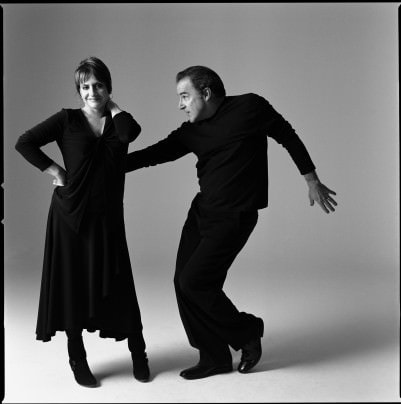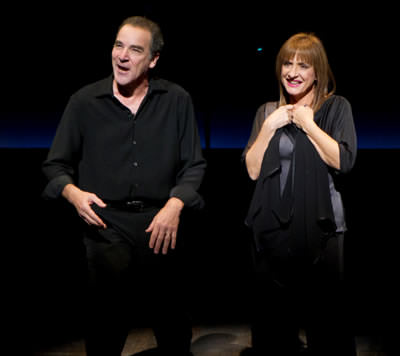If you were going to create a time capsule to preserve a glorious musical theatre partnership, you need look no further than Mandy and Patti in Concert now playing at The Kennedy Center’s Eisenhower Theatre. Having played variations of this concert for several years now, Patinkin and LuPone have refined their concert to emphasize their unique vocal styling and their endearingly quirky flair for comedy. Already iconic and legendary performers in their own right, their obvious fondness for one another (dating back to their starring together in the original Broadway cast of the musical hit Evita) and their theatrical savvy congeal to produce an electric current of sheer all-out showmanship.

The start of the show was magnetic as LuPone and Patinkin appeared standing stoically next to each other (in functional black outfits amidst a cluster of stage lights designed by Production Designer David Korins) on a very minimalistic stage setting singing Sondheim’s classic “Another Hundred People” (from Company) and, then, they both proceeded to engage each other (with obvious signs of affection) with a plunge into several standards from Oscar Hammerstein ll’s wonderful show South Pacific including “A Cockeyed Optimist” and “Some Enchanted Evening”.
It did not take too long to see that this concert was a template for a totally new, radical vision of what would normally be considered your “standard” evening of musical theatre. Gone was conventional show-biz banter and patter. Songs were not introduced but, rather, the entire first act was entirely “sung-through” with each successive song linked organically from the one preceding it. This approach was highly specialized and, obviously, tailored for very discerning and sophisticated tastes.
There was no concerted effort to wow the audience with breaks for applause and jokes but, instead, there was a marked, almost scripted and cinematic feel to the proceedings that might have been disorienting to those who wanted conventional fare. Director Patinkin is propelling a conception (developed by him and his pianist Paul Ford) with sprightly audacious and syncopated Choreography by famed choreographer Ann Reinking that helps to relieve the intensity of this conception. The Lighting Design of Eric Cornwall added to the unique approach of this show as the house lights went on (albeit somewhat dimly) frequently throughout the concert—perhaps this was a deliberate choice to engage the audience and break down the fourth wall for, indeed, Act One was delightful and wonderful but, also, seemingly self-contained in execution. Certainly, Ms. LuPone and Mr. Patinkin were having a veritable “field day” interacting with one another and delivering crisp, natural musical performances like the old troupers that they are. I cannot stress enough, though, how exciting it was to watch such experienced old pros deliver such a totally new approach to a musical theatre concert; I firmly believe that I was witnessing a concert that is distinctly “ahead of its time.”
After this most auspicious beginning, Patinkin and LuPone proceeded to saunter through a very eclectic choice of songs with interspersions of Frank Loesser’s “Baby It’s Cold Outside” (a standout) and Kander and Ebb’s “A Quiet Thing” from Flora the Red Menace (sung almost matter-of-factIy and not in the usual yearning mode by LuPone) helping to balance the beautifully-executed Hammerstein and Sondheim choices. I could sense no discernible theme except, perhaps, a concerted attempt by the performers to stress friendship, love, and reciprocity as the virtues to be instilled from the musical choices chosen for this production. An air of spontaneity seldom seen in a Broadway–style concert setting was achieved through the obvious preparation and discipline that LuPone and Patinkin must have invested to make it all look so easy and effortless. The novelty song “April in Fairbanks” (versus Paris!) by Murray Grand from New Faces of 1956 was a fitting iconoclastic choice for this boldly radical and enticing Act One.
Act Two opened with LuPone and Patinkin appearing in nicely tailored brown apparel and dueting as two elderly and lovable “Old Folks” (from the song of the same name) singing in their rockers to the words and music of Kander and Ebb. LuPone and Patinkin then each did one of their signature tunes: LuPone delivered a searing “Everything’s Coming up Roses” from Gypsy while Patinkin performed an extremely intricate and manic rendition of “The God-Why-Don’t-You-Love-Me Blues” from Sondheim’s Follies (this is the song that Patinkin introduced in the Lincoln Center concert version of Follies).
Up next was a cluster of four songs from what many consider to be Sondheim’s best score—namely, Merrily We Roll Along (but how do you pick a “best” score from Sondheim !?) . Included were “The Hills of Tomorrow,” “Merrily We Roll Along”, “Old Friends” and “Like It Was.” “Old Friends” was quite obviously performed with more than ample resonance as the audience was witnessing a decades- long personal and professional friendship. “Like it Was” was the highlight of the evening with both stars registering a poignant wistfulness in their phrasing.
Act Two eschewed the more scripted cinematic feel of Act One somewhat with the aforementioned signature songs, as well as the reminiscing of LuPone and Patinkin when they were young and conquering Broadway with the Sir Andrew Lloyd Webber and Sir Tim Rice blockbuster musical hit Evita. As a celebration of their friendship forming in Evita, LuPone sang a stunning “Don’t Cry For Me Argentina” and Patinkin sang a rousing and earthy rendition of Oh What a Circus.
I have seen Ms. LuPone perform four times in the past and I must mention that her singing for this concert was intriguing and even, quietly spellbinding, in its almost “zen-like” stillness. She seemed to be singing from a very pure and peaceful part of her psyche and she seemingly eschewed some of the more histrionic flourishes with which she would often conclude her songs. This approach worked beautifully because she has the vocal power and inflection to captivate attention no matter what singing style she utilizes.
Mr. Patinkin, who I have seen twice in the past, has developed deeper chest tones in his vocal delivery and he conveyed this especially well in the last grouping of songs from Rodgers and Hammerstein’s Carousel. Though he still maintains his pleasing falsetto-like tones, his voice has become much rounder with an earthy and deeper robust quality that only adds to his usual appeal. The closing number, “You’ll Never Walk Alone” was sung so movingly by Patinkin and LuPone that two encores were performed with zeal: “You’re Just In Love” from Irving Berlin’s Call Me Madam and “Coffee in a Cardboard Cup” by Kander and Ebb.

Mention must be made of the superb musical accompaniment throughout by Musical Director and Pianist Paul Ford and Dan Hall on Bass. The instrumental embellishment was perfectly subtle for two such powerful singing talents.
An Evening with Patti LuPone and Mandy Patinkin is, I repeat, a template for a new vision of what a Musical Theatre Concert can be. This show propels us into the future.
Running Time: Two Hours, including one intermission.
An Evening with Patti LuPone and Mandy Patinkin plays though this Sunday, February 23rd at The Kennedy Center’s Eisenhower Theater-2700 F Street, NW, in Washington, DC. For tickets, call the box office (202) 467-4600, or purchase them online.




